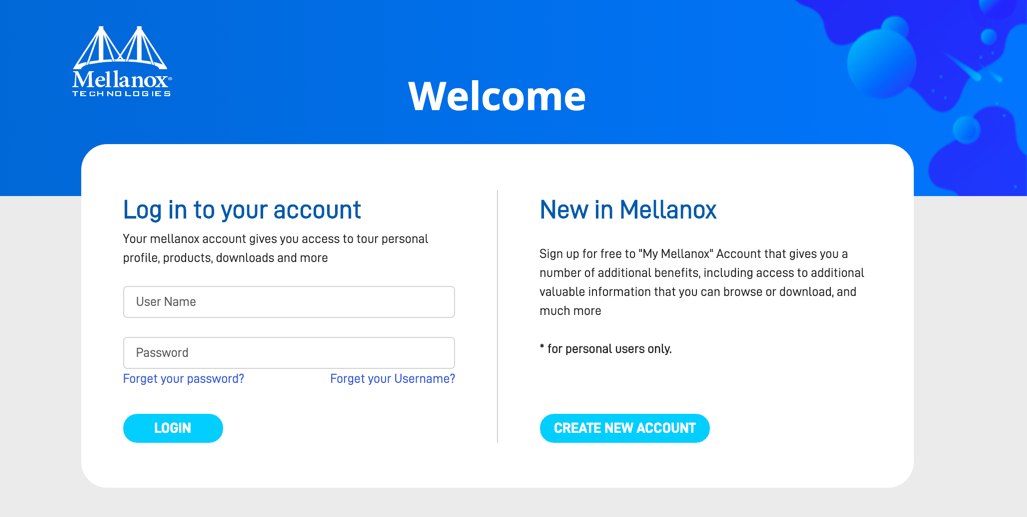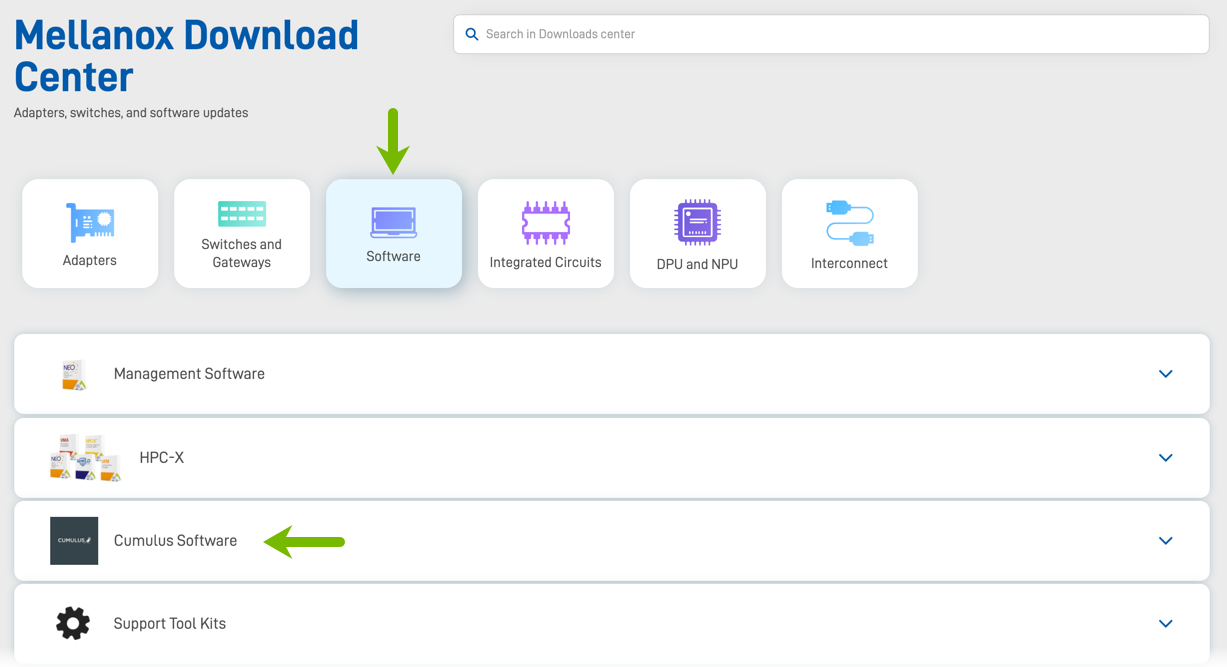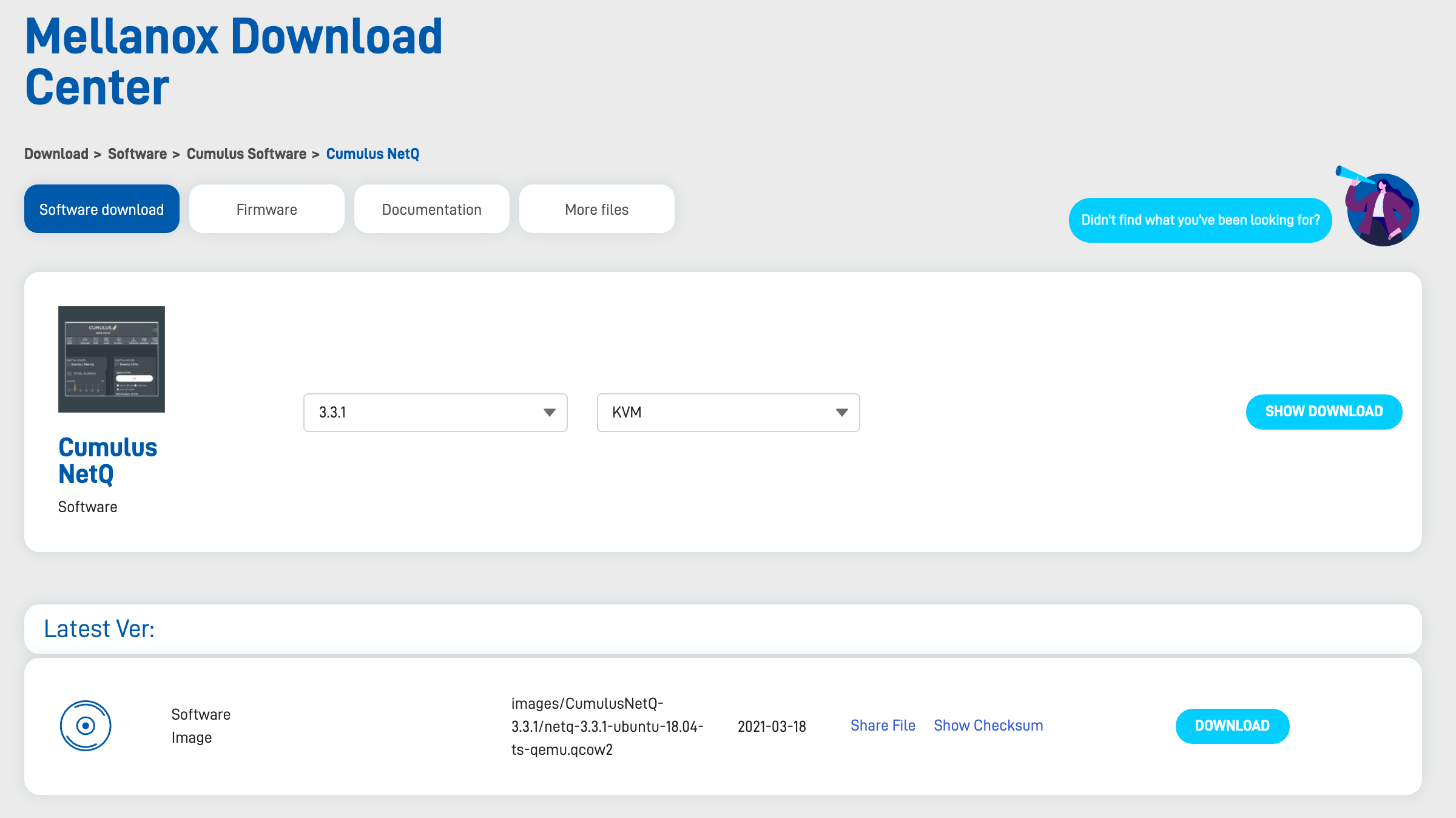Set Up Your KVM Virtual Machine for an On-premises Server Cluster
First configure the VM on the master node, and then configure the VM on each worker node.
Follow these steps to setup and configure your VM on a cluster of servers in an on-premises deployment:
Verify that your master node meets the VM requirements.
Resource Minimum Requirements Processor Eight (8) virtual CPUs Memory 64 GB RAM Local disk storage 256 GB SSD with minimum disk IOPS of 1000 for a standard 4kb block size
(Note: This must be an SSD; use of other storage options can lead to system instability and are not supported.)Network interface speed 1 Gb NIC Hypervisor KVM/QCOW (QEMU Copy on Write) image for servers running CentOS, Ubuntu, and RedHat operating systems Confirm that the needed ports are open for communications.
You must open the following ports on your NetQ on-premises servers:
Additionally, for internal cluster communication, you must open these ports:Port or Protocol Number Protocol Component Access 4 IP Protocol Calico networking (IP-in-IP Protocol) 22 TCP SSH 80 TCP Nginx 179 TCP Calico networking (BGP) 443 TCP NetQ UI 2379 TCP etcd datastore 4789 UDP Calico networking (VxLAN) 5000 TCP Docker registry 6443 TCP kube-apiserver 30001 TCP DPU communication 31980 TCP NetQ Agent communication 31982 TCP NetQ Agent SSL communication 32708 TCP API Gateway Port Protocol Component Access 8080 TCP Admin API 5000 TCP Docker registry 6443 TCP Kubernetes API server 10250 TCP kubelet health probe 2379 TCP etcd 2380 TCP etcd 7072 TCP Kafka JMX monitoring 9092 TCP Kafka client 7071 TCP Cassandra JMX monitoring 7000 TCP Cassandra cluster communication 9042 TCP Cassandra client 7073 TCP Zookeeper JMX monitoring 2888 TCP Zookeeper cluster communication 3888 TCP Zookeeper cluster communication 2181 TCP Zookeeper client 36443 TCP Kubernetes control plane Download the NetQ Platform image.
- On the My Mellanox support page, log in to your account. If needed create a new account and then log in.

Your username is based on your Email address. For example, user1@domain.com.mlnx. - Open the Downloads menu.
- Click Software.
- Open the Cumulus Software option.

- Click All downloads next to Cumulus NetQ.
- Select 4.0.0 from the NetQ Version dropdown.
- Select KVM from the Hypervisor dropdown.
- Click Show Download.

- Verify this is the correct image, then click Download.
The Documentation option lets you download a copy of the user manual. Ignore the Firmware and More files options as these do not apply to NetQ.
- On the My Mellanox support page, log in to your account. If needed create a new account and then log in.
Setup and configure your VM.
Open your hypervisor and set up your VM. You can use this example for reference or use your own hypervisor instructions.
KVM Example Configuration
This example shows the VM setup process for a system with Libvirt and KVM/QEMU installed.
Confirm that the SHA256 checksum matches the one posted on the NVIDIA Application Hub to ensure the image download has not been corrupted.
$ sha256sum ./Downloads/netq-4.0.0-ubuntu-18.04-ts-qemu.qcow2
$ 0A00383666376471A8190E2367B27068B81D6EE00FDE885C68F4E3B3025A00B6 ./Downloads/netq-4.0.0-ubuntu-18.04-ts-qemu.qcow2- Copy the QCOW2 image to a directory where you want to run it.
Tip: Copy, instead of moving, the original QCOW2 image that was downloaded to avoid re-downloading it again later should you need to perform this process again.
$ sudo mkdir /vms
$ sudo cp ./Downloads/netq-4.0.0-ubuntu-18.04-ts-qemu.qcow2 /vms/ts.qcow2 - Create the VM.
For a Direct VM, where the VM uses a MACVLAN interface to sit on the host interface for its connectivity:
$ virt-install --name=netq_ts --vcpus=8 --memory=65536 --os-type=linux --os-variant=generic --disk path=/vms/ts.qcow2,format=qcow2,bus=virtio,cache=none --network=type=direct,source=eth0,model=virtio --import --noautoconsole
Replace the disk path value with the location where the QCOW2 image is to reside. Replace network model value (eth0 in the above example) with the name of the interface where the VM is connected to the external network.
Or, for a Bridged VM, where the VM attaches to a bridge which has already been setup to allow for external access:
$ virt-install --name=netq_ts --vcpus=8 --memory=65536 --os-type=linux --os-variant=generic \ --disk path=/vms/ts.qcow2,format=qcow2,bus=virtio,cache=none --network=bridge=br0,model=virtio --import --noautoconsole
Replace network bridge value (br0 in the above example) with the name of the (pre-existing) bridge interface where the VM is connected to the external network.
Make note of the name used during install as this is needed in a later step.
- Watch the boot process in another terminal window.
$ virsh console netq_ts
Log in to the VM and change the password.
Use the default credentials to log in the first time:
- Username: cumulus
- Password: cumulus
$ ssh cumulus@<ipaddr> Warning: Permanently added '<ipaddr>' (ECDSA) to the list of known hosts. Ubuntu 20.04 LTS cumulus@<ipaddr>'s password: You are required to change your password immediately (root enforced) System information as of Thu Dec 3 21:35:42 UTC 2020 System load: 0.09 Processes: 120 Usage of /: 8.1% of 61.86GB Users logged in: 0 Memory usage: 5% IP address for eth0: <ipaddr> Swap usage: 0% WARNING: Your password has expired. You must change your password now and login again! Changing password for cumulus. (current) UNIX password: cumulus Enter new UNIX password: Retype new UNIX password: passwd: password updated successfully Connection to <ipaddr> closed.
Log in again with your new password.
$ ssh cumulus@<ipaddr> Warning: Permanently added '<ipaddr>' (ECDSA) to the list of known hosts. Ubuntu 20.04 LTS cumulus@<ipaddr>'s password: System information as of Thu Dec 3 21:35:59 UTC 2020 System load: 0.07 Processes: 121 Usage of /: 8.1% of 61.86GB Users logged in: 0 Memory usage: 5% IP address for eth0: <ipaddr> Swap usage: 0% Last login: Thu Dec 3 21:35:43 2020 from <local-ipaddr> cumulus@ubuntu:~$
Verify the master node is ready for installation. Fix any errors indicated before installing the NetQ software.
cumulus@hostname:~$ sudo opta-check
Change the hostname for the VM from the default value.
The default hostname for the NetQ Virtual Machines is ubuntu. Change the hostname to fit your naming conventions while meeting Internet and Kubernetes naming standards.
Kubernetes requires that hostnames are composed of a sequence of labels concatenated with dots. For example, “en.wikipedia.org” is a hostname. Each label must be from 1 to 63 characters long. The entire hostname, including the delimiting dots, has a maximum of 253 ASCII characters.
The Internet standards (RFCs) for protocols specify that labels may contain only the ASCII letters a through z (in lower case), the digits 0 through 9, and the hyphen-minus character ('-').
Use the following command:
cumulus@hostname:~$ sudo hostnamectl set-hostname NEW_HOSTNAME
Add the same NEW_HOSTNAME value to /etc/hosts on your VM for the localhost entry. Example:
127.0.0.1 localhost NEW_HOSTNAME
Run the Bootstrap CLI on the master node. Be sure to replace the eth0 interface used in this example with the interface on the server used to listen for NetQ Agents.
cumulus@
:~$ netq bootstrap master interface eth0 tarball /mnt/installables/netq-bootstrap-4.0.0.tgz Allow about five to ten minutes for this to complete, and only then continue to the next step.
If this step fails for any reason, you can run
netq bootstrap reset [purge-db|keep-db]and then try again.If you have changed the IP address or hostname of the NetQ On-premises VM after this step, you need to re-register this address with NetQ as follows:
Reset the VM, indicating whether you want to purge any NetQ DB data or keep it.
cumulus@hostname:~$ netq bootstrap reset [purge-db|keep-db]
Re-run the Bootstrap CLI. This example uses interface eth0. Replace this with your updated IP address, hostname or interface using the
interfaceorip-addroption.cumulus@
:~$ netq bootstrap master interface eth0 tarball /mnt/installables/netq-bootstrap-4.0.0.tgz Consider the following for container environments, and make adjustments as needed.
Flannel Virtual NetworksIf you are using Flannel with a container environment on your network, you may need to change its default IP address ranges if they conflict with other addresses on your network. This can only be done one time during the first installation.
The address range is 10.244.0.0/16. NetQ overrides the original Flannel default, which is 10.1.0.0/16.
To change the default address range, use the CLI with the
pod-ip-rangeoption. For example:cumulus@hostname:~$ netq bootstrap master interface eth0 tarball /mnt/installables/netq-bootstrap-4.0.0.tgz pod-ip-range 10.255.0.0/16
Docker Default Bridge InterfaceThe default Docker bridge interface is disabled in NetQ. If you need to reenable the interface, contact support.
Verify that your first worker node meets the VM requirements, as described in Step 1.
Confirm that the needed ports are open for communications, as described in Step 2.
Open your hypervisor and set up the VM in the same manner as for the master node.
Make a note of the private IP address you assign to the worker node. You need it for later installation steps.
Verify the worker node is ready for installation. Fix any errors indicated before installing the NetQ software.
cumulus@hostname:~$ sudo opta-check
Run the Bootstrap CLI on the worker node.
cumulus@
:~$ netq bootstrap worker tarball /mnt/installables/netq-bootstrap-4.0.0.tgz master-ip <master-ip> Provide a password using the
passwordoption if required. Allow about five to ten minutes for this to complete, and only then continue to the next step.If this step fails for any reason, you can run
netq bootstrap reset [purge-db|keep-db]on the new worker node and then try again.Repeat Steps 10 through 14 for each additional worker node you want in your cluster.
The final step is to install and activate the NetQ software. You can do this using the Admin UI or the CLI.
Click the installation and activation method you want to use to complete installation:
- Use the Admin UI (recommended)
- Use the CLI